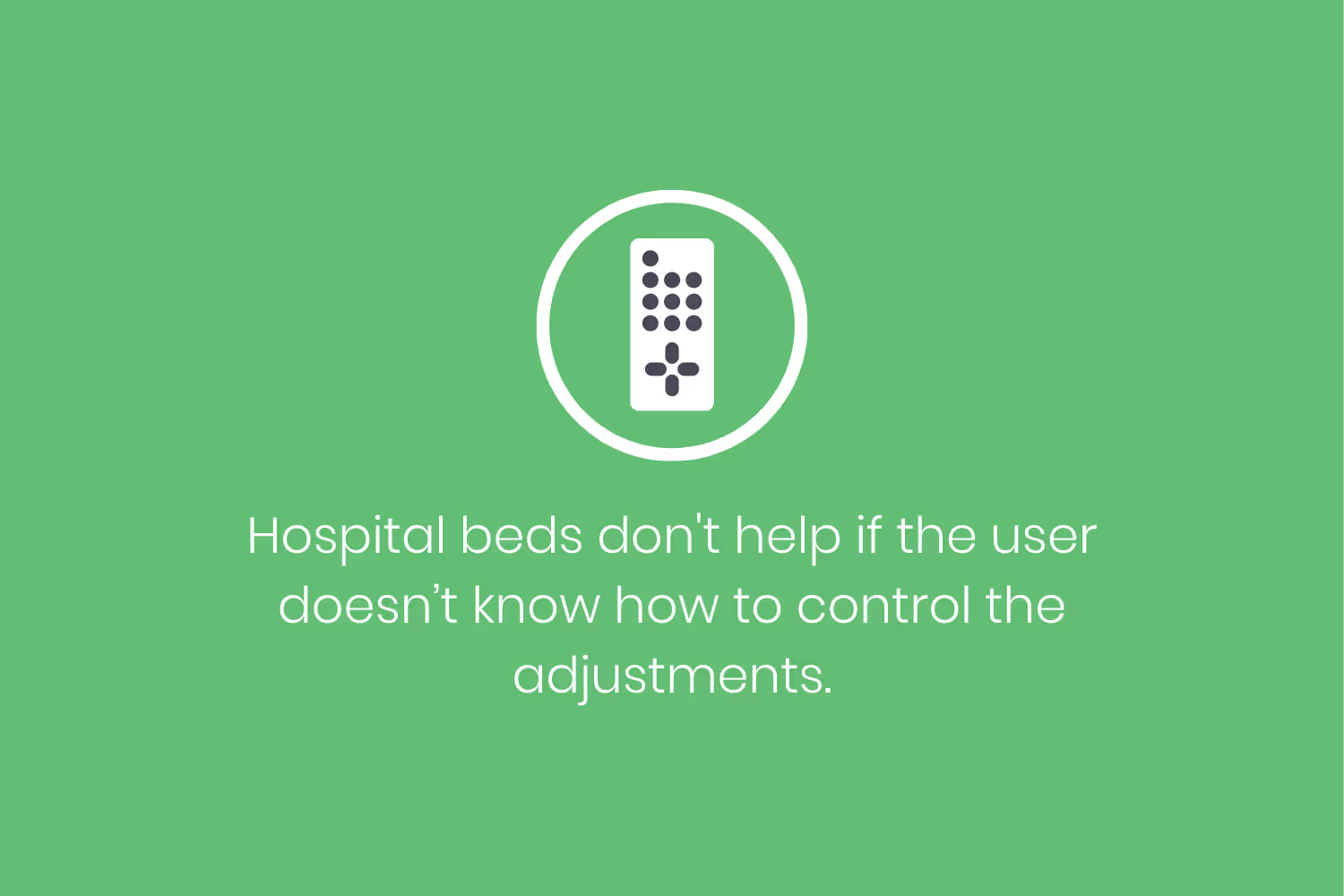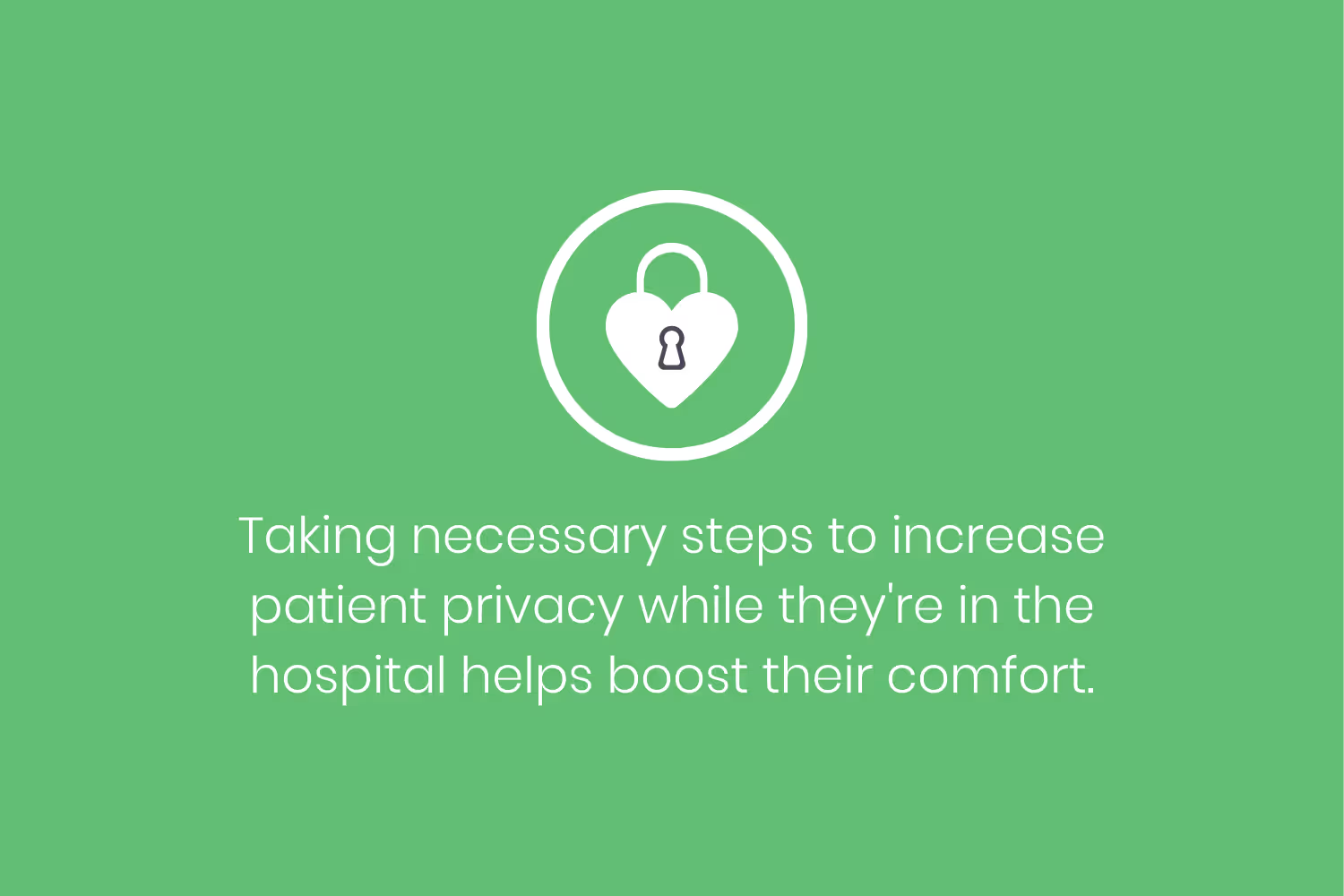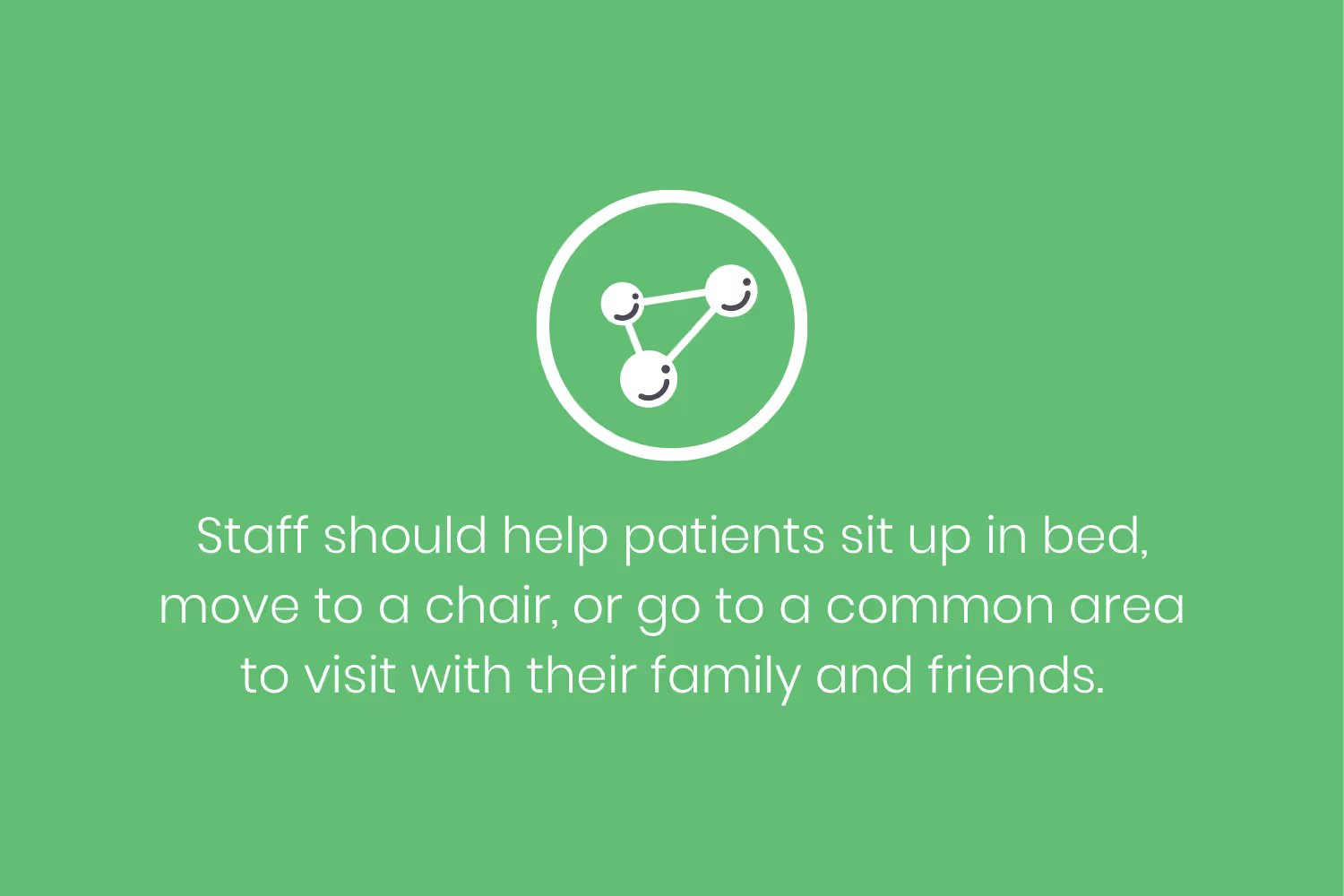11 Fast and Easy Ways for Hospitals to Boost Patient Comfort
Making sure your patients are comfortable is yet another aspect your organization should focus on to better the care that you provide. So what can health centers do to make their atmospheres pleasant for those who need to stay there? Here are 11 easy ways to boost patient comfort.

Imagine a comfortable place.
I bet your mind wanders to your cozy bed or couch at home, the beach, or maybe a quiet coffee shop. There are so many peaceful places we picture. But I’m sure the last setting you would think of is a hospital.
It’s pretty unlikely that anyone would first picture a healthcare facility when thinking of somewhere peaceful. We often associate hospitals with discomfort, pain, sickness and even death. It has a negative connotation.
But for those that do go to the hospital, they should be able to feel comfortable. No matter how long they spend there, a cozy environment can influence better health. People are also more likely to choose that same hospital for any other future treatments or procedures. A 2013 Gallup study confirms that when patients receive excellent care they’ll be more likely to rate a hospital’s quality higher.
But this study isn’t limited to hospitals only, by boosting patient comfort you’re increasing their perception of your practice. In other words, this is yet another aspect your organization should focus on to better the care that you provide.
So what can health centers do to make their atmospheres pleasant for those who need to stay there? Here are 11 easy ways to boost patient comfort.
Explain The Procedure
The first thing that can improve comfort isn’t related to furniture or ergonomics. You need to have your medical professionals explain procedures to their patients.
It’s already an anxious experience as patients worry about their diagnosis (especially if they’ve Googled their symptoms prior). Providing a clear explanation of everything going on during their appointment can help them relax since they’ll know what is going on, how it affects them and how it’ll help them get better.

It also doesn’t hurt to ask them if they have any questions often. They might be too nervous or shy to bring it up, so if the health worker initiates it then they’ll be more comfortable asking.
Frequent Room Checks
In a hospital, patients have a call light so that medical workers know if they need something. These are bedside buttons in the room which signals the nursing station.
Sometimes, people will overuse these call lights for any minor need, even if it's something that doesn’t require a nurse’s attention. Others will do the opposite and not press it at all, even if they have a serious need.
This is why it’s beneficial to check rooms often. The patient might actually need something but hasn’t called for help. And for those who do use the call light too often, it might be because they fear that a nurse won’t come back to check on them. Because of this, they keep requesting help to ease their worry of getting neglected.
But if nurses come into the room often, it builds trust that the staff does focus on safety and won’t neglect any needs. Nurses should set a schedule for rounds at specific time intervals. This gives the patients more confidence knowing that someone will arrive for non-emergent needs.
Even outside of the hospital, this is a beneficial business practice. Have you ever gone to the doctor, got led to your room after spending an inordinate amount of time in their waiting room and then have to wait AGAIN for a long time?
If you have, you know the uneasy feelings that washed over you...
- When are they going to come in?
- How long has it been?
- Did they forget about me?
It’s hard not to ask yourself those anxiety-inducing questions when no one came in to check on you within the past 30 minutes.
So, if you’re in the middle of another appointment but know another of your clients is waiting in their room, peek in and say hi if you walk past it. It only takes a couple of seconds and can really put their mind at ease.
Check Temperature and Air Quality
I’m sure we all know how unpleasant it can be when a room is too hot or too cold. It isn’t enjoyable to feel sticky from sweating or to be constantly shivering. Patients can’t easily change their outfit based on the temperature, grab another blanket, or add some fans to their room.
Checking room temperature helps boost patient comfort. Some people are more sensitive to different temperatures, or their condition could make them feel more hot or cold than usual. Adjusting how their room feels can have a big impact on their overall comfort level.

Something else to consider is the quality of the air. Dehumidifiers and air filters can improve quality for people with conditions like asthma or allergies. These tools prevent mildew and mold while removing particles in the air that can trigger breathing difficulties. Unhealthy air quality won’t contribute to a person’s recovery.
Unfortunately, if air quality isn’t already an option mold might end up forming sooner rather than later. National headlines throughout 2020 read about some of the largest hospitals having issues with black mold in areas where they see clients.
Explain Bed Adjustments
Obviously, hospital beds aren’t like the beds we all have at home. The person laying in them isn’t going to be as comfortable laying in one as they would their own bed. Luckily, they have different settings so people can sit up or lay down at whatever incline they need.
While this is an excellent feature, it doesn’t help if the user doesn’t know how to control the adjustments.

They might end up always keeping it set on the same level because they’re unaware of if they can or how to change it. Teaching them how to adjust the bed to certain settings gives them more control over what feels best.
Increase Inpatient Activity
Speaking of beds, think about when you immediately roll out of bed in the morning.
I bet it takes a few minutes for your muscles to wake up and adjust after laying down for hours. Sometimes we even feel stiff after sitting on the couch for a few hours of inactivity.
But imagine being in a hospital bed for days.
Staying in bed might sound comfy initially, but laying in it too long causes discomfort. Spending so much time in bed leads to a decline in muscle mass and can lead to bedsores.
These are ulcers on areas of the skin that are under too much pressure from lying in bed or sitting in a wheelchair for long periods.
Any amount of mobility can help boost comfort. While those recovering from surgery or severe conditions might not be able to move much, rotating them in bed can help.
But for those who can do a bit more activity, even if it’s as simple as standing up or walking down the hall, they might feel better after moving. It gives them the chance to use their muscles again and stretch out from long periods of immobility.
Provide Easy Access for Overnight Visitors
Most experts agree that allowing visitors helps speed up the recovery process. In fact, a medical study in Italy found that heart attack patients were less stressed when they could see visitors. Being in the presence of their closest friends and family instills a sense of normalcy.
The only problem is that the majority of guests are temporary, they’ll have to leave at night to get some sleep.
Better access for overnight visitors would help convince them to stay. As a result, recovering patients feel more comfortable and guests would feel better knowing that they don’t have to leave their admitted loved ones.

Comfy furniture like a small couch or a reclining chair with an ottoman is a cozy place to sleep on.
In some situations, it could be unsafe or unhealthy to have someone stay in the room with the patient. This is especially true if they share a room with someone else. In this case, having these furniture options in common areas and waiting rooms also works. Being right down the hall or a flight of stairs away is better than leaving outright.
Thinking about your patient demographic will ultimately help you determine how to improve this option.
For example, a children’s hospital might need more of these options. Kids will feel far more nervous about staying at a hospital alone, so there might be more parents who want to stay.
A labor and delivery floor would be similar for having more overnight guests. A new mother may feel better with the father staying, but sharing the same hospital bed would be uncomfortable post-delivery. Having a small couch in the room makes it possible for them to stay together, bond with the baby, and so the father doesn’t need to leave his family.
Implement Quiet Hours
It’s important to be mindful of resting time, especially if the hospital does allow overnight visitors.
Posting quiet hours makes others aware that they need to control their volume and remind them to be conscious of others.
Providing earbuds also improves quiet time. Instead of disturbing others by watching TV or listening to music, patients can use headphones instead.
Another simple rule to tack on to this point is to limit the number of overnight guests or setting specific visitation hours. This helps limit noise that might disturb people from sleeping.
Patients would feel safe if they know that non-staff won’t be wandering through the halls. It could spike their anxiety further if they know that anyone could be walking down the hall and end up entering their room.
Amp Up Privacy
While admitted, patients feel vulnerable to the constant stream of unfamiliar faces coming into their room. If someone who doesn’t work for the hospital came into their room, even by mistake, they’d feel even worse.
There are ways to make sure this doesn’t happen so patients don’t as though privacy isn’t a priority at your hospital.

First, it’s important to clearly label each room with the room number. This way, visitors don’t accidentally walk into the wrong room. The staff could even walk the visitor to the patient’s room. This is good for those who share a room because the stranger won’t startle them.
Having a watch-person in the halls can help too. At night, the nurses have less time with patients so they can be cognizant of who is going into any rooms. Knowing someone is keeping an eye on these areas will help everyone relax.
During the day, it isn’t as likely that someone would notice a person walking into a room that they shouldn’t be. Daytime is busier. This means that there should be a check-in procedure and system for any visitors, and employees must stay aware of who is entering rooms.
Lockdown Your Security Measures
Hospital staff usually says not to bring valuable items or to send them home with a family member. But some patients don’t have anyone that they can give these items to, or they’ll want to keep their phone with them.
It makes people nervous keeping these items out while unattended since anyone could easily walk in and take them. But security measures can improve patients’ comfort with having these personal belongings.
A cabinet to lock personal items in or even a simple drawer to hide things is better than leaving them exposed.
Make It Homey
Like I mentioned at the beginning of this blog post, we might think of a certain room or piece of furniture in our home when we think of a comfortable place. Capturing that homey feeling at a hospital will drastically improve peoples’ comfort levels and an overall sense of security.
Ways that a hospital can do this is by improving their interior design so it seems less like an examination room and more like a hotel stay.
The labor and delivery room from Appalachian Regional Healthcare above is just one example. Even though it’s minimalistic, it looks less like a hospital and more like a baby nursery.
It’s spacious so it doesn’t feel cramped with a newborn and even has a rocking chair and changing table that look like they’re from home. This example also goes back to my point about making it more available for visitors to stay overnight. The small couch and chair make it possible for both parents to stay in the room.
Providing cozy blankets is another great option for making it feel like home. Health facility blankets can be stiff or thin, but many people like to use soft and fluffy blankets at home.
Some organizations donate handmade blankets to health centers. It’s something patients can take home with them and remember that they experienced comfort and care during an unpleasant time.
Add a Social Connection
Social connection promotes healing.
It improves physical and mental health, enhances immune function, and reduces stress consequences. This is why health centers need an environment that focuses on our natural instinct to connect with one another.
There are ways to improve social connections that can boost comfort. Imagine if you were lying in a hospital bed, and all your visitors were surrounding and staring at you in that vulnerable state. Also consider if every time you had friends come to your house, they all gathered in your bedroom. Both of these might seem pretty awkward, but hospital workers can change these situations.

Staff can help patients sit up in bed, move to a chair, or go to a common area to visit with their family and friends. It’s especially important to move to a common area if it’s possible for those who share a room. The roommate might feel bothered by having strangers in the room.
For people who don’t have anyone to visit, health centers can still offer ways to connect. Some use smart devices for video or audio calls so everyone can still receive this social connection. That way, these people still feel comfortable being away from their loved ones.
Conclusion
Even though we might not expect a health center to be pleasant, they need to be. In fact, it’s the one place outside of our homes where it’s imperative because doing so improves the overall healing experience.
It’s demotivating to get better if we always feel uncomfortable. But thankfully, there are steps to take that can boost patient comfort.
Hospitals can never be as comfortable as our favorite places to relax, but they can still have some of the same elements. While hospitals may be an overwhelming place, these options make people feel less stressed about being there.
It shows that the health system not only cares for their patients but that they also care about them on an individual level.
Emphasize your product's unique features or benefits to differentiate it from competitors
In nec dictum adipiscing pharetra enim etiam scelerisque dolor purus ipsum egestas cursus vulputate arcu egestas ut eu sed mollis consectetur mattis pharetra curabitur et maecenas in mattis fames consectetur ipsum quis risus mauris aliquam ornare nisl purus at ipsum nulla accumsan consectetur vestibulum suspendisse aliquam condimentum scelerisque lacinia pellentesque vestibulum condimentum turpis ligula pharetra dictum sapien facilisis sapien at sagittis et cursus congue.
- Pharetra curabitur et maecenas in mattis fames consectetur ipsum quis risus.
- Justo urna nisi auctor consequat consectetur dolor lectus blandit.
- Eget egestas volutpat lacinia vestibulum vitae mattis hendrerit.
- Ornare elit odio tellus orci bibendum dictum id sem congue enim amet diam.
Incorporate statistics or specific numbers to highlight the effectiveness or popularity of your offering
Convallis pellentesque ullamcorper sapien sed tristique fermentum proin amet quam tincidunt feugiat vitae neque quisque odio ut pellentesque ac mauris eget lectus. Pretium arcu turpis lacus sapien sit at eu sapien duis magna nunc nibh nam non ut nibh ultrices ultrices elementum egestas enim nisl sed cursus pellentesque sit dignissim enim euismod sit et convallis sed pelis viverra quam at nisl sit pharetra enim nisl nec vestibulum posuere in volutpat sed blandit neque risus.

Use time-sensitive language to encourage immediate action, such as "Limited Time Offer
Feugiat vitae neque quisque odio ut pellentesque ac mauris eget lectus. Pretium arcu turpis lacus sapien sit at eu sapien duis magna nunc nibh nam non ut nibh ultrices ultrices elementum egestas enim nisl sed cursus pellentesque sit dignissim enim euismod sit et convallis sed pelis viverra quam at nisl sit pharetra enim nisl nec vestibulum posuere in volutpat sed blandit neque risus.
- Pharetra curabitur et maecenas in mattis fames consectetur ipsum quis risus.
- Justo urna nisi auctor consequat consectetur dolor lectus blandit.
- Eget egestas volutpat lacinia vestibulum vitae mattis hendrerit.
- Ornare elit odio tellus orci bibendum dictum id sem congue enim amet diam.
Address customer pain points directly by showing how your product solves their problems
Feugiat vitae neque quisque odio ut pellentesque ac mauris eget lectus. Pretium arcu turpis lacus sapien sit at eu sapien duis magna nunc nibh nam non ut nibh ultrices ultrices elementum egestas enim nisl sed cursus pellentesque sit dignissim enim euismod sit et convallis sed pelis viverra quam at nisl sit pharetra enim nisl nec vestibulum posuere in volutpat sed blandit neque risus.
Vel etiam vel amet aenean eget in habitasse nunc duis tellus sem turpis risus aliquam ac volutpat tellus eu faucibus ullamcorper.
Tailor titles to your ideal customer segment using phrases like "Designed for Busy Professionals
Sed pretium id nibh id sit felis vitae volutpat volutpat adipiscing at sodales neque lectus mi phasellus commodo at elit suspendisse ornare faucibus lectus purus viverra in nec aliquet commodo et sed sed nisi tempor mi pellentesque arcu viverra pretium duis enim vulputate dignissim etiam ultrices vitae neque urna proin nibh diam turpis augue lacus.


.avif)

